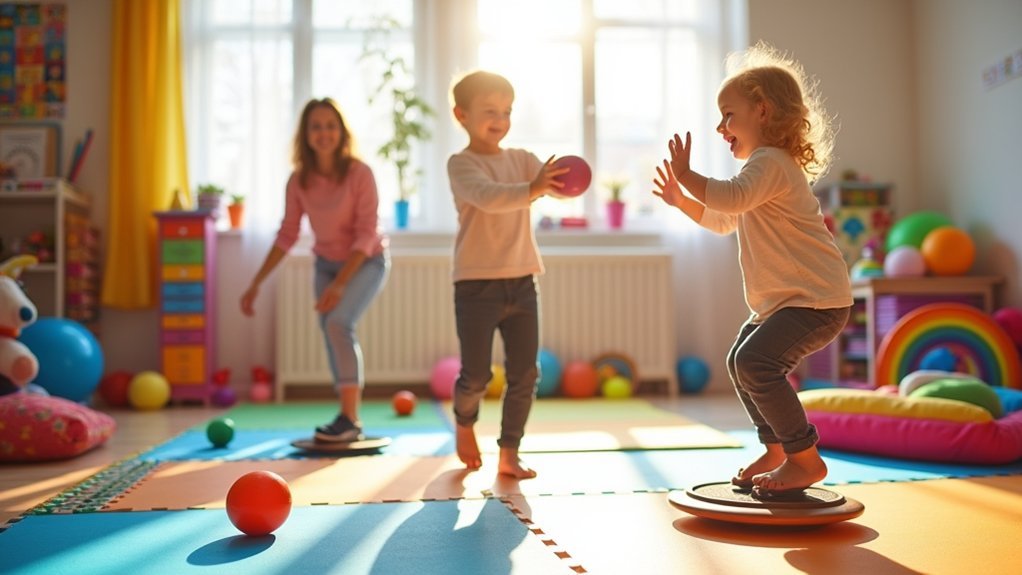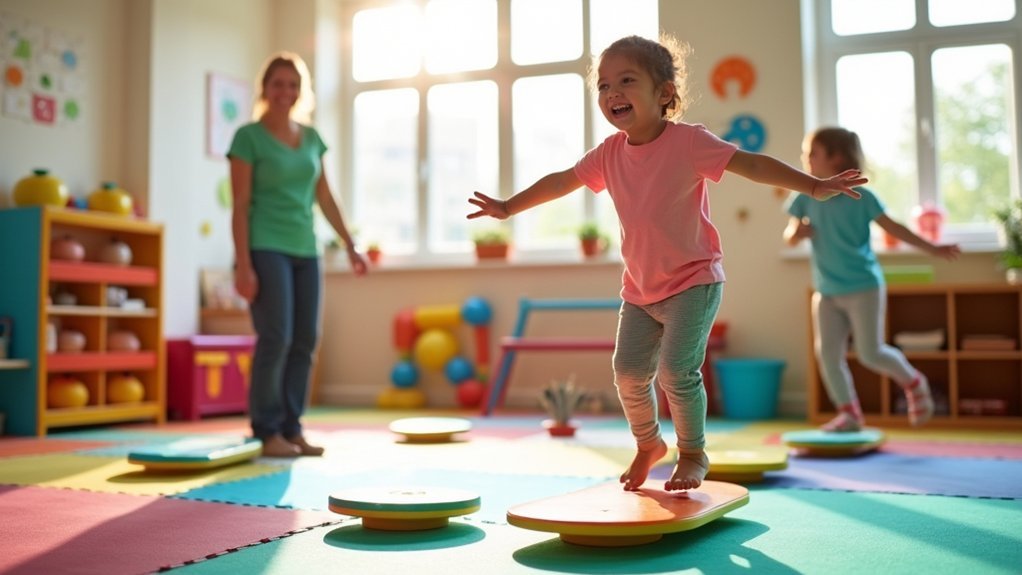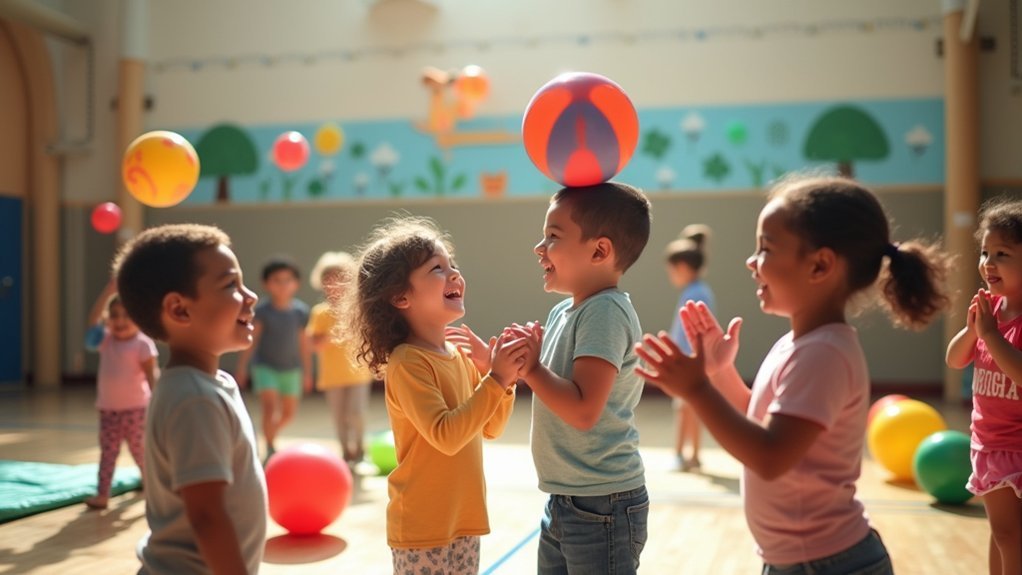The 3 best physical therapy games for autistic children are obstacle courses, balance board activities, and interactive ball games. Obstacle courses develop motor planning through varied textures and movements. Balance boards improve core stability and proprioceptive awareness with engaging wobble challenges. Ball games enhance hand-eye coordination while promoting social interaction and turn-taking skills. These activities can be easily modified to match your child’s specific sensory needs and developmental goals. Discover how these playful approaches transform therapy into fun adventures.
Understanding Autism and Physical Therapy Benefits

While autism spectrum disorder (ASD) presents unique challenges in behavior, social interaction, and communication, physical therapy offers remarkable benefits for children maneuvering this journey.
If your child has autism, you’ll notice that targeted therapy interventions can greatly improve their motor skills and coordination through structured physical activity.
Early intervention is key. Physical therapy helps your child develop fundamental movement patterns that boost independence in daily activities.
Starting physical therapy early gives children with autism the movement foundation they need for greater self-reliance.
You’ll see improvements in both gross and fine motor skills, balance, and body awareness. Research shows these activities also reduce repetitive behaviors while enhancing social skills.
Sensory Integration Through Obstacle Courses
Creating adaptable obstacle courses stands as one of the most effective physical therapy games for children with autism. You’ll find that using everyday items to design these courses stimulates motor planning and spatial awareness, essential components of sensory integration.
By incorporating varied textures and movement styles, you’re enhancing tactile and proprioceptive experiences that support your child’s sensory processing abilities. Personalize each obstacle to address specific sensory needs, making the activity both therapeutic and enjoyable.
These courses naturally encourage problem-solving skills while improving physical skills and agility. Consider adding timed challenges or team-based elements to foster social interaction.
Your child won’t just be climbing, crawling, and balancing—they’ll be developing vital sensory integration skills while having fun, making obstacle courses a versatile addition to their physical therapy routine.
Balance and Coordination Games With Balance Boards

Balance boards offer exciting wobble board challenges that you’ll find surprisingly effective for children with autism spectrum disorder.
You can introduce simple posture improvement activities where your child maintains balance while reaching for objects or following directional commands.
These balance games not only strengthen core muscles but also enhance your child’s body awareness and coordination skills in a playful, non-threatening environment.
Wobble Board Challenges
The humble wobble board offers three powerful benefits for autistic children: improved core stability, enhanced balance, and developed coordination. As your child stands on the wobbly surface, they’re developing proprioceptive awareness by constantly adjusting their body position. You’ll notice their confidence building with each session as they master increasingly difficult challenges.
| Level | Activity | Benefit |
|---|---|---|
| Beginner | Sit on board | Core stability |
| Beginner | Kneel while holding support | Balance awareness |
| Intermediate | Stand with assistance | Coordination |
| Intermediate | Toss/catch ball while balancing | Motor skills integration |
| Advanced | Eyes-closed balancing | Sensory processing |
Try tailoring these wobble board challenges to your child’s abilities. The physical fitness benefits extend beyond the exercise itself, as these enjoyable activities engage children in ways that translate to everyday movement skills.
Posture Improvement Activities
Four essential posture improvement games using balance boards can transform how autistic children develop body awareness.
Start with “Surfer’s Challenge,” where children stand on the board while mimicking surfing movements, engaging their core muscles and enhancing proprioceptive feedback.
Try “Animal Walks,” having children maintain balance while imitating different creatures, which builds coordination and strengthens postural control.
“Simon Says Balance” combines focus and concentration with posture improvement as children follow directions while staying stable.
For advanced motor skill development, introduce “Balance Board Bowling,” where they knock down pins while maintaining equilibrium.
These tailored activities seamlessly integrate into physical therapy sessions, allowing you to address each child’s specific needs while making posture development engaging and effective.
Water-Based Activities for Motor Development
Water-based activities offer your autistic child a supportive environment where they can practice floating balance exercises with minimal joint stress.
You’ll find that the buoyancy helps them develop core strength and body awareness while the water’s gentle resistance improves muscle coordination.
Underwater texture exploration introduces sensory stimulation as your child touches various objects beneath the surface, enhancing both fine motor skills and sensory processing simultaneously.
Floating Balance Exercises
Swimming pools provide an ideal therapeutic environment for children with autism to develop essential motor skills through floating balance exercises. The water’s buoyancy reduces joint stress, allowing your child to practice motor development with less effort and greater confidence.
These water-based activities improve coordination and proprioception by enhancing body awareness and spatial orientation. You’ll notice your child’s anxiety reducing as the calming water environment helps them focus better during motor skills practice.
You can customize floating balance exercises to match your child’s needs on the autism spectrum disorder—incorporate kicking, reaching, and turning to build motor planning abilities.
Group sessions add valuable social interaction opportunities while simultaneously improving physical fitness. The supportive aquatic setting makes these exercises particularly effective for children who struggle with traditional land-based therapy approaches.
Underwater Texture Exploration
Exploring underwater textures offers children with autism a unique sensory experience that combines the calming properties of water with tactile stimulation.
You’ll find that the buoyancy of water creates an ideal environment for motor development, reducing joint stress while allowing easier movement and coordination practice.
Set up a shallow pool with various textured objects—sponges, soft toys, and textured balls—for your child to discover.
As they reach for and manipulate these items, they’ll develop fine motor skills, improving dexterity and grip strength during therapy sessions.
Encourage swimming through different materials to enhance proprioceptive feedback and body awareness.
Group activities in water promote social interaction as children learn to cooperate in a low-pressure setting.
These tactile experiences support sensory integration in a fun, therapeutic way that children genuinely enjoy.
Interactive Ball Games for Social-Motor Skills

Because they combine physical activity with social interaction, interactive ball games provide exceptional therapeutic benefits for children with autism. You’ll notice improved hand-eye coordination as your child engages in games like balloon volleyball and bean bag toss. These activities encourage teamwork and communication skills through turn-taking and collaboration.
| Game Type | Skills Developed | Benefits |
|---|---|---|
| Balloon Badminton | Hand-eye coordination | Low-pressure environment |
| Bean Bag Toss | Throwing accuracy | Builds confidence |
| Balloon Volleyball | Gross motor skills | Promotes social inclusion |
Incorporating these games into therapy sessions helps children develop essential physical abilities like throwing, catching, and balancing. As they practice in a structured, supportive setting, you’ll see noticeable improvements in their confidence and willingness to participate in physical activities, supporting overall physical development.
Therapeutic Movement Through Dance and Music
The combination of music and dance creates a powerful therapeutic medium for autistic children struggling with motor development and sensory processing.
Dance therapy enhances motor coordination while giving children a meaningful outlet for self-expression in a supportive setting.
You’ll notice improved socialization skills as your child interacts with others through structured movement activities. The rhythmic elements stimulate auditory processing pathways while simultaneously promoting emotional regulation and reducing anxiety levels.
For best results, tailor dance routines to your child’s individual preferences—this keeps them engaged and motivated to participate consistently.
Research confirms that regular therapeutic movement sessions improve not just physical fitness but overall quality of life for children on the spectrum.
The holistic benefits of dance extend beyond the physical, nurturing emotional well-being through creative expression.
Proprioceptive Activities With Resistance Bands
Resistance bands offer powerful proprioceptive input for autistic children struggling with body awareness and spatial orientation. These flexible tools provide immediate tactile feedback during pulling, pushing, and stretching exercises, helping children better understand where their bodies are in space.
Resistance bands deliver essential sensory feedback, helping autistic children map their bodies in relation to the world around them.
You’ll find these bands particularly effective for building muscle strength and coordination—both essential components of motor skills development. Start with light resistance and gradually increase as your child’s confidence grows.
The beauty of resistance bands is their versatility; you can easily tailor activities to match individual needs and abilities.
Beyond physical benefits, regular proprioceptive activities with resistance bands can greatly reduce anxiety and improve focus during physical therapy sessions. The engaging, playful nature of band exercises keeps children interested, turning therapeutic work into enjoyable games they’ll want to continue.
Creating a Supportive Environment for Therapy Success
Creating the right environment for physical therapy goes beyond selecting appropriate activities like resistance bands.
You’ll find that individualized approaches tailored to your child’s interests greatly boost engagement and participation. Structured settings reduce anxiety and help your child feel more comfortable during therapy sessions.
Establish sensory-friendly spaces that minimize overwhelming stimuli, fostering a positive atmosphere for therapeutic activities.
Don’t underestimate the power of social support from peers and family—it builds confidence and encourages continued involvement.
Regular collaboration with specialized physical therapists guarantees therapy environments adapt to meet your child’s evolving needs.
Frequently Asked Questions
What Games Are Good for Autistic Children?
You’ll find obstacle courses, “Free the Animals,” “Red Light, Green Light,” “Simon Says,” water play, and balloon badminton excellent for your autistic child. They’ll develop motor skills while having fun in engaging environments.
What Are the Physical Activities for Autistic Children?
You’ll find structured activities like yoga, swimming and martial arts benefit autistic children. Try team sports, obstacle courses, dance therapy, and tailored exercise programs to improve motor skills, social interaction and emotional regulation.
What Are ADL Activities for Autism Children?
ADL activities for autistic children include dressing, brushing teeth, bathing, eating, and toileting. You’ll find they’re most effective when you use visual schedules, break tasks into small steps, and provide consistent positive reinforcement.
What Is the Best Play Therapy for Autism?
The best play therapy for autism combines structured activities with your child’s interests. You’ll see progress using Floortime, sensory play, and social skills games that encourage communication while respecting their unique sensory needs.
In Summary
You’ll find that incorporating these physical therapy games into your child’s routine can transform challenges into opportunities. As you create a supportive environment, you’re not just improving their motor skills but also building confidence and social connections. Remember, consistency is key, and celebrating small victories along the way will make the therapeutic journey more rewarding for both you and your child.





Leave a Reply